|
1.
Stomata 12 or more rows per band; E Himalayas, SW China.......2 1. Stomata less than 12 rows per band ... ........ .. . . . .3
2.
Persistent bud-scales nerveless, or nearly so, concave, |
Key to Species of the Taxus Wallichiana Group
IA. Subgroup Wallichiana
©The
World Botanical Associates Web Page
Prepared by Richard W. Spjut
April 2003
|
1.
Stomata 12 or more rows per band; E Himalayas, SW China.......2 1. Stomata less than 12 rows per band ... ........ .. . . . .3
2.
Persistent bud-scales nerveless, or nearly so, concave, |
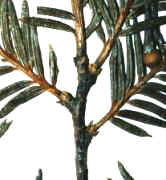 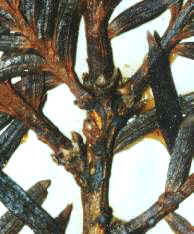 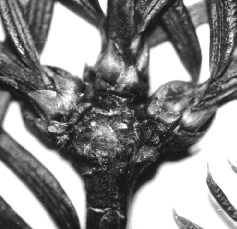
Fig.
2123: Taxus wallichiana var. wallichiana from Nepal, Wallich
6054A (K). Fig. 21 (left): note contrast between yellowish orange
branchlets and older dark maroon branch, and seed. Fig. 22 (isosyntype):
from a male plant showing loosely adherent, tooth-like scales. Fig. 23
(right): from Khasia, India Hooker & Thomson 77 ex Herb. Bunge
(P), showing close-up of persistent bud-scales. |
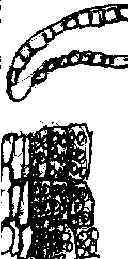 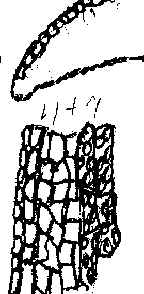
Fig. 2425, scanned from author's sketches on 3x5 inch packet envelopes of microscopic leaf sections of Taxus wallichiana showing T-sect. of leaf near margin and as seen on abaxial epidermal surface (~ 250Χ). Fig. 24 (left): var. yunnanensis, from Zayul, Tibet (topotype), Kingdon Ward 10398 (BM ). Fig. 25 (right): var. wallichiana, Griffith 2606 from Assam, India (BM). |
|
2a.
Leaves nearly lanceolate (Fig. 26), the undersurface with epidermal
cells in 2a.
Leaves
linear (Fig. 27), the undersurface with epidermal cells in T-sect. of |
|
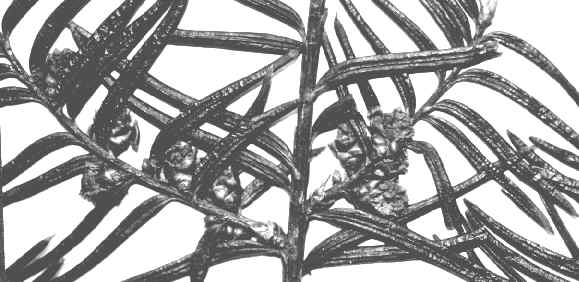 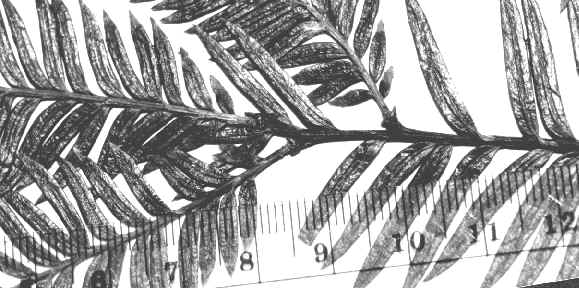
Fig.26 (left).
Taxus wallichiana var. yunnanensis, Wang 67412 from Yunnan,
China (A), showing lanceolate type of leaf. Fig.
27 (right).
Taxus wallichiana var.
wallichiana, Griffith 5002 from East Himalaya (P), showing
linear type of leaf. |
|
3.
Abaxial leaf epidermal cells gradually narrower and shorter from stomata
band 3.
Abaxial leaf epidermal cells abruptly shorter and wider in marginal
region, |
|
|
4.
Papillae prominent on most of the abaxial 4.
Papillae less prominent on midrib and |

Fig. 28. Abaxial surface near mid region
of leaf, drawn from
|
|
5.
Stomata
710 (-12 rows); China (Yunnan,
Sichuan)...............................................................
2.
Taxus florinii 5. Stomata 47 (-9) rows; Pacific NW America.......................................................................1. Taxus brevifolia
Fig. 3033: Taxus florinii. From left to right, Fig. 30: from Sichuan, China, Fliegner et al. 1129 (K), showing sharp contrast in color between upper and lower leaf surfaces. Fig. 31: from NW Yunnan, with pale yellowish seed on young shoot, Rock 18502 (US). Fig. 3233: T-section (above) and abaxial view (below) of leaf near margin (mid region of leaf), showing variation in length and shape of cells, Fig. 32 from Yunnan, Yu 7848 (BM), Fig. 33 from Sichuan, Schneider 2918 (K). This species has leaf characteristics between T. globosa and T. brevifolia, distinguished from them mostly by slightly shorter cells in height on the abaxial (ventral) leaf surface. |
|